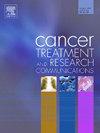PARP抑制剂治疗小细胞肺癌:临床试验的系统回顾和荟萃分析
Q3 Medicine
引用次数: 0
摘要
背景:小细胞肺癌(SCLC)是一种神经内分泌癌,其特点是具有侵袭性行为,预后差,治疗选择有限。聚adp -核糖聚合酶抑制剂(PARPi)是一种新型抗癌药物,可诱导DNA损伤并导致DNA修复受损的肿瘤细胞死亡,被称为合成致死概念。本研究旨在从现有的临床试验数据分析PARPi对SCLC患者的疗效和安全性。方法:研究报告PARPi治疗SCLC患者的有效性和安全性,根据PRISMA声明在5个数据库中检索,这些数据库具有预定的资格标准。使用合适的工具进行关键评估,提取结果并进行分析。结果:纳入5项随机对照临床试验,451例介入患者和308例对照SCLC患者。分析显示无进展生存期(PFS)增加(RR 0.92 (95% CI 0.84-1.00;p=0.05))和客观缓解率(ORR) (RR 1.27 (95% CI 1.07-1.50;p=0.007)),总生存期(OS)无显著差异(RR 1.03 (95% CI 0.92-1.15;p=0.60)),严重治疗紧急不良事件(teae)的风险增加(RR 1.13 (95% CI 0.95-1.35;p=0.16))在接受parpi的SCLC患者中。在血液学毒性中,亚分析显示血小板减少的风险最高,其次是中性粒细胞减少、贫血、白细胞减少和淋巴细胞减少。结论:在SCLC患者的化疗方案中加入PARPi可导致PFS和ORR增加,OS和teae风险增加无差异。需要进一步和更大规模的临床研究来验证PARPi治疗SCLC患者的有效性和安全性。本文章由计算机程序翻译,如有差异,请以英文原文为准。
PARP inhibitors as therapy for small cell lung carcinoma: A systematic review and meta-analysis of clinical trials
Background
Small Cell Lung Cancer (SCLC) is a neuroendocrine carcinoma characterized by aggressive behavior and poor prognosis with limited treatment options. Poly ADP-Ribose Polymerase inhibitors (PARPi) are novel anti-cancer agents that induce DNA damages and cause cell death in tumor cells with impaired DNA repair, known as the synthetic lethality concept. This study aimed to analyze the efficacy and safety of PARPi for patients with SCLC from available clinical trial data.
Methods
Studies reporting efficacy and safety of PARPi therapy for SCLC patients were searched across five databases with predetermined eligibility criteria in accordance with the PRISMA statement. Critical appraisal was done using suitable tools, outcomes were extracted, and analyzed.
Results
Five randomized controlled clinical trials with 451 interventional patients and 308 control patients with SCLC were included. The analysis showed increased Progression-Free Survival (PFS) (RR 0.92 (95 %CI 0.84–1.00; p=0.05)) and Objective Response Rate (ORR) (RR 1.27 (95 %CI 1.07–1.50; p=0.007)), no significant difference in Overall Survival (OS) (RR 1.03 (95 %CI 0.92–1.15; p=0.60)), and an increased risk for serious Treatment Emergent Adverse Events (TEAEs) (RR 1.13 (95 %CI 0.95–1.35; p=0.16)) in PARPi-receiving SCLC patients. Amongst the hematologic toxicities, sub-analysis showed that thrombocytopenia had the highest risk, followed by neutropenia, anemia, leukopenia, and lymphopenia.
Conclusion
The addition of PARPi in the chemotherapy regimen for patients with SCLC results in increased PFS and ORR, with no difference in OS and an increased risk of TEAEs. Further and larger clinical studies are needed to validate the efficacy and safety of PARPi therapy for SCLC patients.
求助全文
通过发布文献求助,成功后即可免费获取论文全文。
去求助
来源期刊

Cancer treatment and research communications
Medicine-Oncology
CiteScore
4.30
自引率
0.00%
发文量
148
审稿时长
56 days
期刊介绍:
Cancer Treatment and Research Communications is an international peer-reviewed publication dedicated to providing comprehensive basic, translational, and clinical oncology research. The journal is devoted to articles on detection, diagnosis, prevention, policy, and treatment of cancer and provides a global forum for the nurturing and development of future generations of oncology scientists. Cancer Treatment and Research Communications publishes comprehensive reviews and original studies describing various aspects of basic through clinical research of all tumor types. The journal also accepts clinical studies in oncology, with an emphasis on prospective early phase clinical trials. Specific areas of interest include basic, translational, and clinical research and mechanistic approaches; cancer biology; molecular carcinogenesis; genetics and genomics; stem cell and developmental biology; immunology; molecular and cellular oncology; systems biology; drug sensitivity and resistance; gene and antisense therapy; pathology, markers, and prognostic indicators; chemoprevention strategies; multimodality therapy; cancer policy; and integration of various approaches. Our mission is to be the premier source of relevant information through promoting excellence in research and facilitating the timely translation of that science to health care and clinical practice.
 求助内容:
求助内容: 应助结果提醒方式:
应助结果提醒方式:


